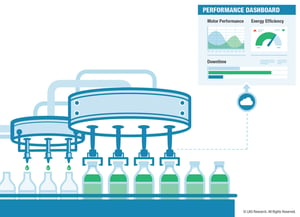LNS Research spends a great deal of our time exploring and writing about Industrial Transformation (IX), including best practices around people, processes, and technology. However, many small and mid-sized businesses (SMB) are not ready for the scope and impact of IX projects – they’re already behind in technology adoption, and don’t have the personnel or budget required to take on a full-blown IX project. These companies however must still compete against larger, resource-rich organizations that are moving ahead with the latest technologies and are seeing step-change improvements in their operations thanks to the new Industrial Internet of Things (IIoT) solutions. So, how can SMBs compete?
Improve Performance with Metrics and Analytics
 The good news is that even small, mid-size, and resource-constrained businesses can build strong Continuous Improvement (CI) programs and management-by-metrics (and analytics) cultures. Of note is that our research on companies that use metrics or analytics data within the organization shows that manufacturers with higher technology manufacturers with higher technology and operations maturity report pushing data and decisions closer to the plant floor. In contrast, those companies that lag peers in operations maturity tend to reserve data and decisions to top managers and the C-suite. Our research has consistently shown that empowering factory workers with the ability to make smart choices drives higher performance across a wide range of measurements; companies that limit the data and decisions to top management tend to lag on the same performance metrics. This empowerment of plant personnel should be easier to accomplish at SMB companies, where there are fewer layers between top management and the factory.
The good news is that even small, mid-size, and resource-constrained businesses can build strong Continuous Improvement (CI) programs and management-by-metrics (and analytics) cultures. Of note is that our research on companies that use metrics or analytics data within the organization shows that manufacturers with higher technology manufacturers with higher technology and operations maturity report pushing data and decisions closer to the plant floor. In contrast, those companies that lag peers in operations maturity tend to reserve data and decisions to top managers and the C-suite. Our research has consistently shown that empowering factory workers with the ability to make smart choices drives higher performance across a wide range of measurements; companies that limit the data and decisions to top management tend to lag on the same performance metrics. This empowerment of plant personnel should be easier to accomplish at SMB companies, where there are fewer layers between top management and the factory.
The Technology Challenge for SMBs
One of the challenges for SMBs is that these companies are probably a generation or more behind in software for their factories. According to reports published by LNS Research, less than half of SMB manufacturers have manufacturing execution system (MES) / manufacturing operations management (MOM) solutions implemented or in pilot stages (44%). This shortfall makes it difficult for them to measure performance and put in place the CI programs that are the foundation of world-class manufacturing.
The technology gap also puts SMBs at a competitive disadvantage. One of the more surprising findings in our recent research is that companies who manage their Continuous Improvement programs with advanced technology show a 2x to 3x improvement in outcomes, as compared to companies manually tracking these programs. While an improvement isn’t surprising, the dramatic impact of digitalization is notable.
This gain holds for small and mid-size businesses as well: For instance, SMB manufacturers that use digital technologies to track programs show a 300% increase in first pass yield. The inference is clear - SMBs need to focus on Continuous Improvement programs and manage by metrics to achieve significant results; they can use advanced technologies to track the CI programs and accelerate improvements by a marked amount. We anticipate these gains will compound over time to deliver significantly higher corporate performance.
Planning the Move from Metrics to Analytics
SMBs have generally used a dashboard of simple metrics to show the up-to-the-second status of machines and operations, to improve response time and time-to-resolution when issues occur. The advent of advanced analytics technology, however, provides an opportunity to leap forward, all the way to prescriptive control of operations from real-time analytics; that is, when an analytics system tracks and diagnoses (or predicts) problems in a process, that same analytics system can now recommend an action to fix or prevent those problems. This promises to be a tremendous advantage for companies who deploy the technology and trust it enough to close the loop.
At large companies, data silos and organizational silos are often a challenge when it comes to analytics; for example, financial data and operational data exist in separate databases with strict access controls in place, making it difficult to include this data in analytics. As large companies attempt to solve this challenge and prepare systems for the move to predictive or prescriptive analytics, nimbler small and mid-size companies have a significant advantage and may take steps to catch up to – and even surpass - their larger rivals. The scale of the challenge at SMBs is smaller, and the problems easier to overcome. Enabling an analytics solution to access operational data and financial data should be easier for a small and mid-size manufacturer. This provides a path for SMBs to achieve the promise of advanced analytics more quickly and efficiently than their large competitors.
Summary
Small teams and tight finances shouldn’t completely block progress towards Industrial Transformation. Small and mid-sized manufacturers can take advantage of their ability to move quickly to expand their digital capabilities, especially around Continuous Improvement programs and Digital Lean, to close the competitive gap between their operations and those of their large competitors. For the SMB where a full-scale Industrial Transformation isn’t in the cards for the foreseeable future, it’s imperative to improve operations performance – and using digital technologies to move from metrics to analytics is one of the most impactful steps they can take.